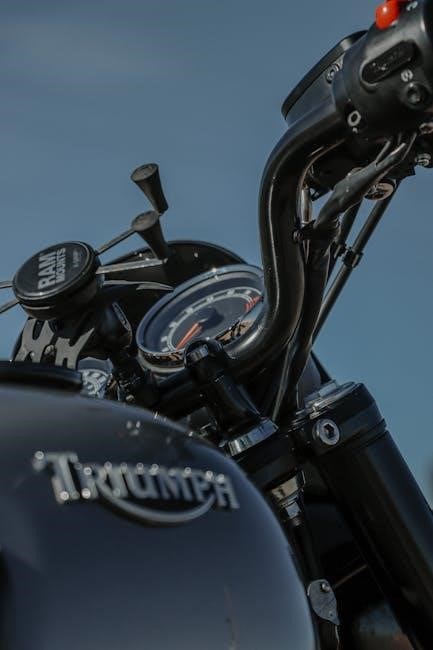Power brakes use a booster to assist braking, reducing pedal effort, while manual brakes rely solely on driver input, offering a simpler, more direct driving experience․
Understanding Power Brakes
Power brakes utilize a booster connected to the master cylinder, employing engine vacuum to apply force, reducing driver effort and enabling smoother, more efficient braking performance consistently․
What Are Power Brakes?
Power brakes are systems that use a vacuum booster to assist in applying brake pressure, reducing the effort needed to press the pedal․ This system incorporates a master cylinder connected to the booster, which amplifies the force applied to the brakes․ Power brakes are designed to make braking easier and more efficient, especially in vehicles with larger engines or heavier loads, where manual braking might be insufficient․
How Power Brakes Work
Power brakes function by using a vacuum booster connected to the master cylinder, amplifying the force applied to the brake pedal․ When the pedal is pressed, the booster uses vacuum pressure to assist in applying pressure to the master cylinder․ This amplified force is then transmitted through the brake lines to the brake calipers or wheel cylinders, enabling the vehicle to stop with less effort from the driver․ The system relies on engine vacuum or a vacuum pump to provide the necessary assistance, making braking easier and more efficient․
Advantages of Power Brakes
Power brakes offer significant advantages, including reduced pedal effort, making braking easier and less tiring․ The vacuum booster amplifies braking force, enabling quicker stops and better control, especially in emergency situations․ This system is particularly beneficial for heavier vehicles, as it reduces the physical strain on the driver․ Additionally, power brakes enhance overall braking performance, providing a safer and more responsive driving experience compared to manual brakes․
Understanding Manual Brakes
Manual brakes rely solely on driver input without power assistance, offering a simpler system with fewer components and direct control over braking, appealing to purists and lightweight vehicles․
What Are Manual Brakes?
Manual brakes operate without power assistance, relying solely on the driver’s effort to apply pressure to the brake pedal․ This system uses a master cylinder directly connected to the brake components, eliminating the need for a power booster․ Manual brakes are simpler in design, with fewer parts, which can reduce maintenance and potential failures․ They are often preferred in lightweight vehicles or by drivers who value direct control and a more tactile driving experience․ This simplicity also makes them lighter, contributing to better overall vehicle performance․ Additionally, manual brakes are commonly found in older or classic cars, where preserving the original mechanical setup is important for authenticity and functionality․

How Manual Brakes Work
Manual brakes function by directly transferring the driver’s pedal effort to the master cylinder, which then sends brake fluid pressure through the brake lines to the wheels․ Without a power booster, the system relies entirely on the driver’s leg strength to apply pressure․ When the pedal is pressed, it activates the master cylinder, pushing fluid to the calipers or wheel cylinders, which then engage the brake pads or shoes against the rotors or drums to slow or stop the vehicle․ This straightforward mechanism ensures reliable operation with minimal components involved․
Advantages of Manual Brakes
Manual brakes offer a simpler, more direct braking system with fewer components, reducing the risk of failure and maintenance needs; They provide better driver feedback and control, fostering a stronger connection to the vehicle․ Without a power booster, manual brakes are lighter and more cost-effective, making them ideal for performance or minimalist builds․ Additionally, they eliminate reliance on engine vacuum or external power sources, ensuring consistent braking even in situations where power assist systems might fail․ This simplicity also reduces parasitic power loss, enhancing overall efficiency․

Comparison of Power Brakes and Manual Brakes
Power brakes use a booster to reduce pedal effort, while manual brakes rely on direct driver input․ Power brakes offer easier operation but add complexity, whereas manual brakes provide simplicity and direct control, often preferred for performance driving․
Key Differences Between Power and Manual Brakes

The primary distinction lies in the use of a brake booster in power brakes, which reduces pedal effort, while manual brakes rely solely on driver input․ Power brakes utilize engine vacuum or an electric pump to assist braking, making them easier to operate․ Manual brakes, however, lack this assistance, requiring more pedal pressure but offering a simpler, more direct system․ Key components differ as well: power brakes include a booster connected to the master cylinder, whereas manual systems omit this part, resulting in fewer parts and reduced complexity․
Braking Performance and Stopping Distance
Power brakes generally offer superior braking performance and shorter stopping distances due to the added assistance from the brake booster, which amplifies braking force․ This results in quicker and more consistent stops, especially in emergency situations․ Manual brakes, while reliable, require more pedal effort, which can lead to longer stopping distances, particularly in urgent braking scenarios․ The absence of power assistance means drivers must apply more force, potentially affecting reaction time and control․ However, with proper setup and maintenance, manual brakes can still deliver effective braking performance, though not as effortlessly as power-assisted systems․
Pedal Pressure and Driver Effort
Power brakes significantly reduce the pedal pressure required, making braking easier and less physically demanding, especially in repeated or emergency stops․ The brake booster amplifies the force applied to the pedal, reducing driver effort․ Manual brakes, however, demand more leg strength and consistent pressure, as there is no assistance․ While the difference in effort is noticeable, manual brakes are still manageable for most drivers, provided the system is properly configured․ The choice often comes down to personal preference, vehicle setup, and the trade-off between simplicity and convenience․
When to Choose Power Brakes vs Manual Brakes
Power brakes are ideal for vehicles needing reduced pedal effort, while manual brakes suit lighter vehicles or drivers preferring a more direct, simplistic braking experience․
Situations Where Power Brakes Are Preferred
- Power brakes are ideal for vehicles requiring reduced pedal effort, such as heavier cars or trucks․
- They are preferred in modern vehicles for smoother, more responsive braking․
- Power brakes excel in emergency stops, providing quicker and more controlled deceleration․
- They are beneficial for drivers who need assistance with braking due to physical limitations․
- Power brakes are advantageous in hilly or mountainous regions where frequent braking is necessary․
Situations Where Manual Brakes Are Preferred
- Manual brakes are ideal for lightweight vehicles where reduced weight and simplicity are prioritized․
- They are preferred in racing or performance driving for direct pedal feel and control․
- Manual brakes are beneficial in situations where mechanical simplicity and reliability are crucial․
- They are often chosen for budget-friendly projects or older vehicles with fewer components․
- Manual brakes are favored when drivers prefer a more connected, non-assisted braking experience․

Maintenance and Reliability
Power brakes require regular inspection of the booster and vacuum system, while manual brakes need less maintenance due to their simpler design and fewer components․
Maintenance Requirements for Power Brakes
Power brakes require regular maintenance of the brake booster, vacuum lines, and master cylinder․ The booster must be inspected for leaks, and the vacuum supply should be checked for proper function․ The master cylinder needs to be monitored for fluid levels and any signs of wear․ Additionally, the pedal assembly should be lubricated periodically to ensure smooth operation․ Regular inspection of the entire system is crucial to prevent potential failures and maintain reliable braking performance․ Proper upkeep ensures the power assist function works efficiently, providing consistent stopping power and driver safety․
Maintenance Requirements for Manual Brakes

Manual brakes require routine inspection of the master cylinder, brake lines, and pedal assembly․ The system has fewer components, simplifying maintenance․ Brake fluid levels should be checked regularly, and any leaks addressed promptly․ The pedal linkage must be lubricated to prevent stiffness and ensure smooth operation․ Manual systems are less complex, reducing the need for specialized tools or adjustments․ Regular inspections ensure reliable performance, making manual brakes a low-maintenance option for drivers seeking simplicity and durability in their braking system․

Cost Considerations
Power brakes typically have higher initial costs due to additional components like boosters, while manual brakes are more affordable with fewer parts and simpler systems․
Initial Cost of Power Brakes vs Manual Brakes
Power brakes generally have a higher initial cost due to the addition of a brake booster and related components․ Manual brakes, being simpler systems, are more cost-effective upfront․ The cost difference is primarily attributed to the complexity and parts required for power-assisted systems․ However, the added components in power brakes contribute to reduced driver effort and improved braking performance․ Manual brakes, on the other hand, offer savings in both parts and installation, making them a budget-friendly option for many drivers․
Long-Term Cost Implications
Power brakes may incur higher long-term costs due to the potential for booster failures and additional maintenance needs․ Manual brakes, with fewer components, tend to be more reliable and require less frequent repairs․ Over time, manual systems often prove more economical, as their simplicity reduces the likelihood of costly malfunctions․ However, power brakes may offset their higher maintenance costs through improved braking performance and reduced wear on other components, such as brake pads and rotors, due to more controlled braking efforts․
The choice between power brakes and manual brakes depends on specific needs and preferences․ Power brakes offer enhanced braking performance and reduced pedal effort, making them ideal for vehicles requiring consistent and reliable stopping power․ Manual brakes, while simpler and more cost-effective, demand more driver input but provide a direct, unassisted driving experience․ Ultimately, the decision should align with the vehicle’s intended use, driver preference, and the importance of convenience versus simplicity․ Both systems have their advantages, and the right choice ensures optimal safety and control on the road․


